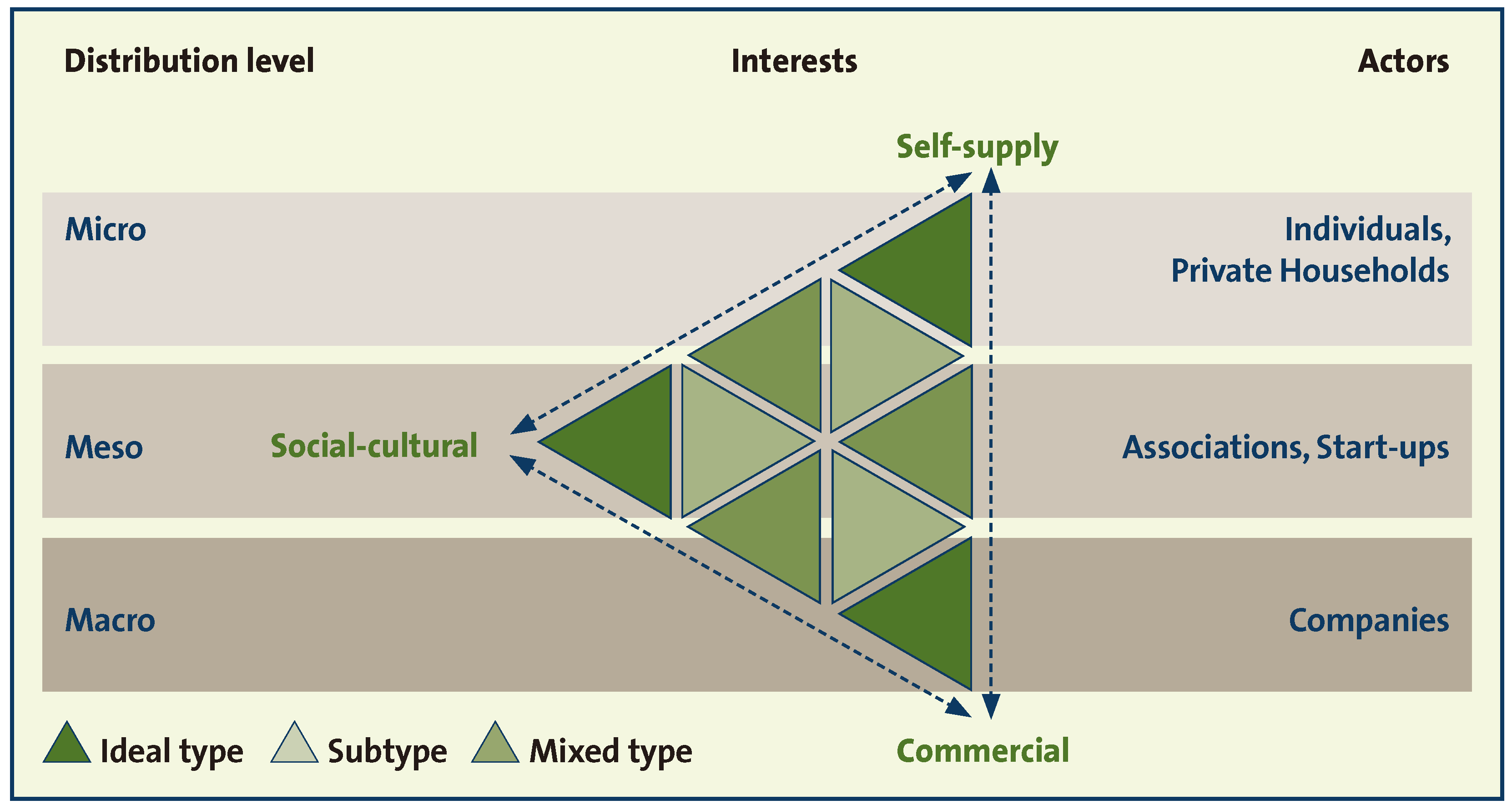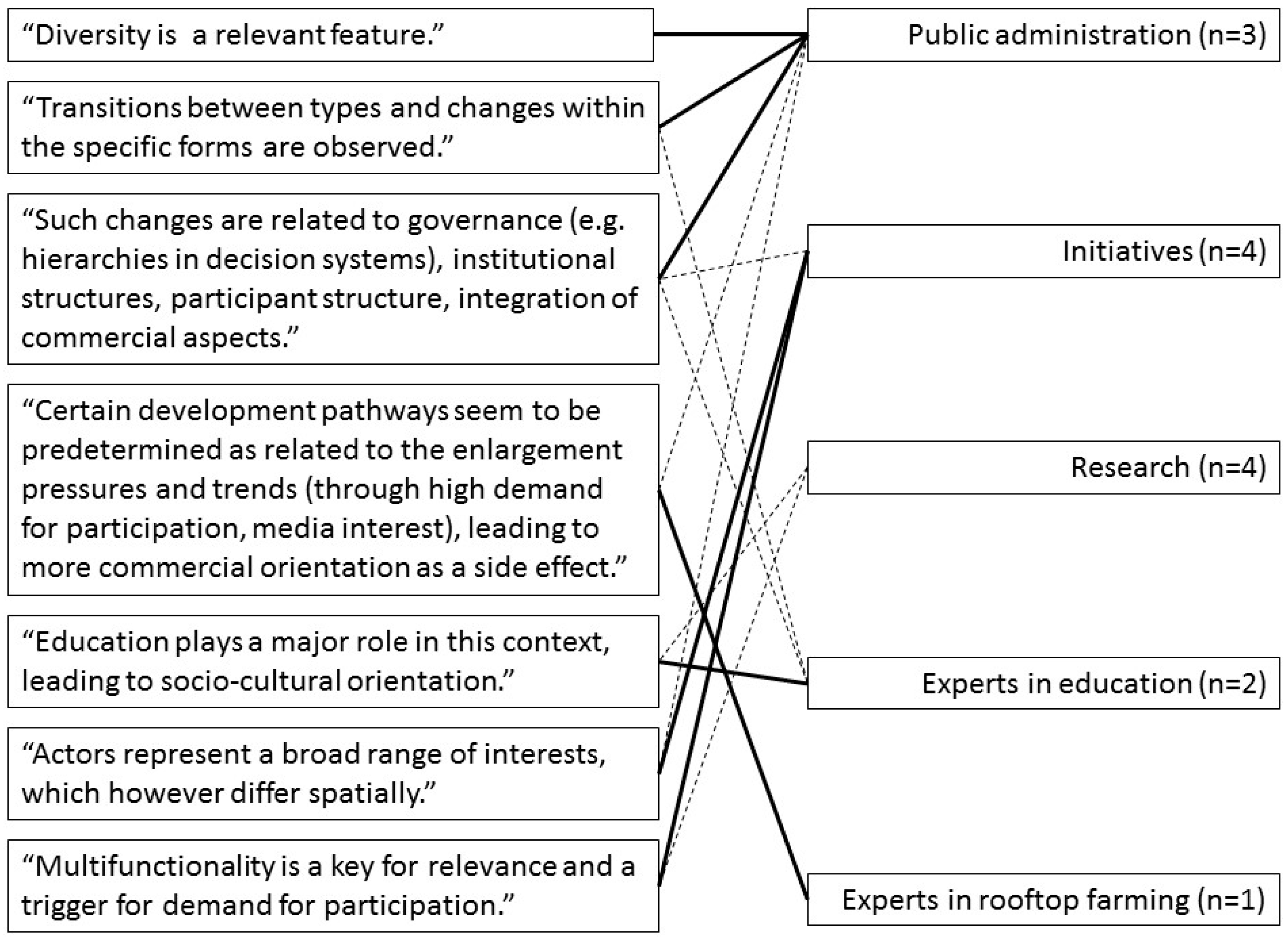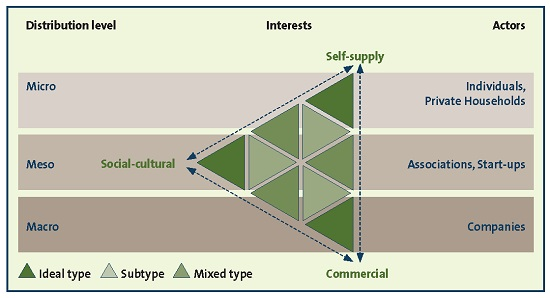Urban Agriculture Oriented towards Self-Supply, Social and Commercial Purpose: A Typology
Abstract
:1. Introduction
1.1. Forms and Motivations of Urban Agriculture
1.2. Objective and Structure of the Paper
2. Theory Building and Benefits for Decision-Making
2.1. Theory Building on Urban Agriculture and the Role of Typologies
2.2. Governance Issues that Could Benefit from a Typology
3. Materials and Methods
3.1. Development of a Typology
3.2. Empirical Test of Validity of the Typology
3.3. Stakeholder Workshop on the Operational Value of the Typology
4. Results
4.1. Typology for Urban Agriculture
4.1.1. Ideal Types
4.1.2. Subtypes
4.1.3. Mixed Types
4.1.4. Dynamics within Urban Agriculture
4.2. Empirical Test of Validity
4.3. Operational Value for Stakeholders
5. Discussion
6. Conclusions
Acknowledgments
Author Contributions
Conflicts of Interest
Abbreviations
| UA | Urban Agriculture |
| UAI | Urban Agriculture Initiative |
| CSA | Community-Supported Agriculture |
| IT | Ideal Type |
| SD | Subtype |
| MD | Mixed Type |
References
- FAO. Agricultural Management, Marketing and Finance Occasional Paper 19. Available online: ftp://ftp.fao.org/docrep/fao/010/a1471e/a1471e00.pdf (accessed on 18 January 2015).
- Mougeot, L.J.A. Urban Agriculture: Definition, Presence and Potentials and Risks. Growing Cities Growing Food: Urban Agriculture on the Policy Agenda: A Reader on Urban Agriculture; Bakker, N., Dubbeling, M., Guendel, S., Sabel Koschella, U., de Zeeuw, H., Eds.; DSE: Feldafing, Germany, 2001. Available online: http://www.ruaf.org/sites/default/files/Theme1_1_1.PDF (accessed on 19 February 2015).
- Berges, R.; Opitz, I.; Piorr, A.; Krikser, T.; Lange, A.; Bruszewska, K.; Specht, K.; Henneberg, C. Urbane Landwirtschaft—Innovationsfelder für die nachhaltige Stadt? Leibniz-Zentrum für Agrarlandschaftsforschung (ZALF) e. V.: Müncheberg, Germany, 2014. Available online: http://project2.zalf.de/innsula/downloads/Berges%20et%20al%202014%20Urbane%20Landwirtschaft%20%E2%80%93%20Innovationsfelder%20f%C3%BCr%20die%20nachhaltige%20Stadt.pdf (accessed on 13 February 2015).
- Opitz, I.; Berges, R.; Piorr, A.; Krikser, T. Contributing to food security in urban areas: Differences between urban agriculture and peri-urban agriculture in the Global North. Agric. Hum. Values. 2016, 33, 341–358. [Google Scholar] [CrossRef]
- Specht, K.; Siebert, R.; Hartmann, I.; Freisinger, U.; Sawicka, M.; Werner, A.; Thomaier, S.; Henckel, D.; Walk, H.; Dierich, A. Urban agriculture of the future: An overview of sustainability aspects of food production in and on buildings. Agric. Hum. Values. 2013, 33, 33–51. [Google Scholar] [CrossRef]
- De Graaf, P.A. Room for urban agriculture in Rotterdam: defining the spatial opportunities for urban agriculture within the industrialized city. In Sustainable Food Planning: Evolving Theory and Practice; Viljoen, A., Wiskerke, J.S.C., Eds.; Wageningen Academic Publishers Books: Wageningen, The Netherlands, 2012; pp. 533–546. [Google Scholar]
- Alkon, A. Paradise or pavement: The social constructions of the environment in two urban farmers' markets and their implications for environmental justice and sustainability. Local. Environ. 2008, 13, 271–289. [Google Scholar] [CrossRef]
- King, C.A. Community resilience and contemporary agri-ecological systems: Reconnecting people and food, and people with people. Syst. Res. Behav. Sci. 2008, 25, 111–124. [Google Scholar] [CrossRef]
- Okvat, H.A.; Zautra, A.J. Community gardening: A parsimonious path to individual, community, and environmental resilience. Am. J. Community Psychol. 2011, 47, 374–387. [Google Scholar] [CrossRef] [PubMed]
- Bonacich, E.; Alimahomed-Wilson, J. Confronting racism, capitalism, and ecological degradation: Urban farming and the struggle for social justice in black Los Angeles. Souls 2011, 13, 213–226. [Google Scholar] [CrossRef]
- Holland, L. Diversity and connections in community gardens: A contribution to local sustainability. Local. Environ. 2004, 9, 285–305. [Google Scholar] [CrossRef]
- Lyson, T.A. Civic agriculture and community problem solving. Cult. Agric. 2005, 27, 92–98. [Google Scholar] [CrossRef]
- Saldivar-Tanaka, L.; Krasny, M.E. Culturing community development, neighborhood open space, and civic agriculture: The case of Latino community gardens in New York City. Agric. Hum. Values. 2004, 21, 399–412. [Google Scholar] [CrossRef]
- Travaline, K.; Hunold, C. Urban agriculture and ecological citizenship in Philadelphia. Local environment. Int. J. Justice. Sustain. 2010, 15, 581–590. [Google Scholar] [CrossRef]
- Opitz, I.; Specht, K.; Berges, R.; Siebert, R.; Piorr, A. Toward sustainability: Novelties, areas of learning and innovation in urban agriculture. Sustainability 2016, 8. [Google Scholar] [CrossRef]
- Curtis, K.R.; Cowee, M.W. Direct marketing local food to chefs: Chef preferences and perceived obstacles. J. Food. Distrib. Res. 2009, 40, 26–36. [Google Scholar]
- Inwood, S.M.; Sharp, J.S.; Moore, R.H.; Stinner, D.H. Restaurants, chefs and local foods: insights drawn from application of a diffusion of innovation framework. Agric. Hum. Values. 2009, 26, 177–191. [Google Scholar] [CrossRef]
- Mills, R.J.; Westfall, S.J. How the sustainable food movement has created the new farm to table industry. Am. Soci. Bus. Behav. Sci. 2011, 7, 66–78. [Google Scholar]
- Lovell, S.T.; DeSantis, S.; Nathan, C.A.; Olson, M.B.; Méndez, V.E.; Kominami, H.C.; Erickson, D.L.; Morris, K.S.; Morris, W.B. Integrating agroecology and landscape multifunctionality in Vermont: An evolving framework to evaluate the design of agroecosystems. Agric. Sys. 2010, 103, 327–341. [Google Scholar] [CrossRef]
- Altieri, M.A.; Nicholls, C.; Funes, F. The Scaling up of Agroecology: Spreading the Hope for Food Sovereignty and Resiliency; Sociedad Científica Latinoamericana de Agroecología (SOCLA), 2012; pp. 1–20. Available online: http://futureoffood.org/pdfs/SOCLA_2012_Scaling_Up_Agroecology_Rio20.pdf (accessed on 13 February 2015).
- Sonnino, R.; Marsden, T. Beyond the divide: Rethinking relationships between alternative and conventional food networks in Europe. J. Econ. Geogr. 2006, 6, 181–199. [Google Scholar] [CrossRef]
- Méndez, V.E.; Bacon, C.M.; Cohen, R. Agroecology as a transdisciplinary, participatory, and action-oriented approach. Agroecol. Sustain. Food. Sys. 2013, 37, 3–18. [Google Scholar]
- Dalgaard, T.; Hutchings, N.; Porter, J.R. Agroecology, scaling and interdisciplinarity. Agric. Ecosyst. Environ. 2003, 100, 39–51. [Google Scholar] [CrossRef]
- Hammond, B.; Berardi, G.; Green, R. Resilience in agriculture: Small-and medium-sized farms in northwest Washington State. Agroecol. Sustain. Food. Syst. 2013, 37, 316–339. [Google Scholar] [CrossRef]
- Sage, C. Social embeddedness and relations of regard: Alternative ‘good food’ networks in south-west Ireland. J. Rural. Stud. 2003, 19, 47–60. [Google Scholar] [CrossRef]
- Nost, E. Scaling-up local foods: Commodity practice in community supported agriculture (CSA). J. Rural. Stud. 2014, 34, 152–160. [Google Scholar] [CrossRef]
- Repp, A.; Weith, T. Building bridges across sectors and scales: exploring systemic solutions towards a sustainable management of land—Experiences from 4th year status conference on research for sustainable land management. Land 2015, 4, 325–336. [Google Scholar] [CrossRef]
- Van Veenhuizen, R. Cities Farming for the Future—Urban Agriculture for Green and Productive Cities; RUAF Foundation, IDRC and IIRR Publishing: Silang, Philippines, 2006. [Google Scholar]
- Comstock, N.; Dickinson, L.M.; Marshall, J.A.; Soobader, M.; Turbin, M.S.; Buchenau, M.; Litt, J.S. Neighborhood attachment and its correlates: Exploring neighborhood conditions, collective efficacy, and gardening. J. Environ. Psychol. 2010, 30, 435–442. [Google Scholar] [CrossRef]
- Kortright, R.; Wakefield, S. Edible backyards: A qualitative study of household food growing and its contributions to food security. Agric. Hum. Values. 2011, 28, 39–53. [Google Scholar] [CrossRef]
- Delind, L.B.; Bingen, J. Place and civic culture: re-thinking the context for local agriculture. J. Agric. Environ. Ethics. 2008, 21, 127–151. [Google Scholar] [CrossRef]
- Corrigan, M.P. Growing what you eat: Developing community gardens in Baltimore, Maryland. Appl. Geogr. 2011, 31, 1232–1241. [Google Scholar] [CrossRef]
- Lautenschlager, L.; Smith, C. Beliefs, knowledge, and values held by inner-city youth about gardening, nutrition, and cooking. Agric. Hum. Values. 2007, 24, 245–258. [Google Scholar] [CrossRef]
- Blair, D. The child in the garden: An evaluative review of the benefits of school gardening. J. Environ. Educ. 2009, 40, 15–38. [Google Scholar] [CrossRef]
- Ozer, E.J. The effects of school gardens on students and schools: Conceptualization and considerations for maximizing healthy development. Health. Educ. Behav. 2007, 34, 846–863. [Google Scholar] [CrossRef] [PubMed]
- Skelly, S.M.; Bradley, J.C. The growing phenomenon of school gardens: Measuring their variation and their effect on students' sense of responsibility and attitudes toward science and the environment. Appl. Environ. Educ. Commun. 2007, 6, 97–104. [Google Scholar] [CrossRef]
- Pudup, M.B. It takes a garden: Cultivating citizen-subjects in organized garden project. Geoforum 2008, 39, 1228–1240. [Google Scholar] [CrossRef]
- Colasanti, K.J.A.; Hamm, M.W. Assessing the local food supply capacity of Detroit, Michigan. J. Agric. Food. Syst. Commun. Dev. 2010, 1, 41–58. [Google Scholar] [CrossRef]
- Condon, P.M.; Mullinix, K.; Fallick, A.; Harcourt, M. Agriculture on the edge: strategies to abate urban encroachment onto agricultural lands by promoting viable human-scale agriculture as an integral element of urbanization. Int. J. Agric. Sustain. 2010, 8, 104–115. [Google Scholar] [CrossRef]
- Kremer, P.; DeLiberty, T.L. Local food practices and growing potential: Mapping the case of Philadelphia. Appl. Geogr. 2011, 31, 1252–1261. [Google Scholar] [CrossRef]
- MacRae, R.; Gallant, E.; Patel, S.; Michalak, M.; Bunch, M.; Schaffner, S. Could Toronto Provide 10% of its fresh vegetable requirements from within its own boundaries? Matching consumption requirements with growing spaces. J. Agric. Food. Systs. Community Dev. 2010, 1, 105–127. [Google Scholar]
- Metcalf, S.S.; Widener, M.J. Growing Buffalo’s capacity for local food: A systems framework for sustainable agriculture. Appl. Geogr. 2011, 31, 1242–1251. [Google Scholar] [CrossRef]
- Vogl, C.R.; Axmann, P.; Vogl-Lukasser, B. Urban organic farming in Austria with the concept of Selbsternte (’self-harvest‘): An agronomic and socio-economic analysis. Renew. Agric. Food. Syst. 2004, 19, 67–79. [Google Scholar] [CrossRef]
- Stierand, P. Stadtentwicklung Mit Dem Gartenspaten; Selbstverlag: Dortmund, Germany, 2012. [Google Scholar]
- EU SCAR. Agricultural Knowledge and Innovation Systems in Transition – A Reflection Paper. 2012. Available online: http://ec.europa.eu/research/bioeconomy/pdf/ki3211999enc_002.pdf (accessed on 19 February 2015).
- Grewal, S.S.; Grewal, P.S. Can cities become self-reliant in food? Cities 2012, 29, 1–11. [Google Scholar] [CrossRef]
- Lynch, K.; Maconachie, R.; Binns, T.; Tengbe, P.; Bangura, K. Meeting the urban challenge? Urban agriculture and food security in post-conflict Freetown, Sierra Leone. Appl. Geogr. 2013, 36, 31–39. [Google Scholar]
- Voicu, I.; Been, V. The effect of community gardens on neighboring property values. Real Estate Economics. 2008, 36, 241–283. [Google Scholar] [CrossRef]
- Nugent, R. The Impact of Urban Agriculture on the Household and Local Economies. 2000. Available online: http://wentfishing.net/farmlit/Theme3.pdf (accessed on 19 February 2015).
- Brown, K.H.; Jameton, A.L. Public health implications of Urban Agriculture. J. Public. Heal. Polic. 2000, 21, 20–39. [Google Scholar] [CrossRef]
- Blake, M.K.; Mellor, J.; Crane, L. Buying local food: Shopping practices, place, and consumption networks in defining food as “Local”. Ann. Assoc. Am. Geogr. 2010, 100, 409–426. [Google Scholar] [CrossRef]
- Feagan, R. Direct Marketing: Towards sustainable local food systems? Local. Environ. 2008, 13, 161–167. [Google Scholar] [CrossRef]
- Kerton, S.; Sinclair, A.J. Buying local organic food: A pathway to transformative learning. Agric. Hum. Values. 2010, 27, 401–413. [Google Scholar] [CrossRef]
- Seyfang, G. Avoiding Asda? Exploring consumer motivations in local organic food networks. Local. Environ. 2008, 13, 187–201. [Google Scholar] [Green Version]
- Doty, D.H.; Glick, W.H. Typologies as a unique form of theory building: Toward improved understanding and modelling. Acad. Manag. Rev. 1994, 19, 230–251. [Google Scholar]
- O´Raghallaigh, P.; Sammon, D.; Murphy, G. Theory-building using typologies—A worked example on building a typology of knowledge activities for innovation. In Bridging the Socio-Technical Gap in Decision Support Systems; Respício, A., Adam, F., Phillips-Wren, G.E., Teixeira, C., Telhada, J., Eds.; IOS Press: Amsterdam, The Netherlands, 2010; pp. 371–382. [Google Scholar]
- Meredith, J. Theory building through Conceptual Methods. Int. J. Oper. Product. Manag. 1992, 13, 3–11. [Google Scholar] [CrossRef]
- Lin, N. Foundations of Social Research; McGraw-Hill: New York, NY, USA, 1976. [Google Scholar]
- Hazeu, G.W.; Metzger, M.J.; Mücher, C.A.; Pérez-Soba, M.; Renetzeder, C.; Andersen, E. European environmental stratifications and typologies: An overview. Agric. Ecosyst. Environ. 2011, 142, 29–39. [Google Scholar] [CrossRef]
- Anderson, J.R.; Hardy, E.E.; Roach, J.T.; Witmer, R.E. A Land Use and Land Cover Classification System for Use with Remote Sensing Data; United States Government Office: Washington, DC, USA, 1976; p. 964.
- Huynh Thanh, H.; Franke, C.; Piorr, A.; Lange, A.; Zasada, I. Target groups of rural development policies: Development of a surveybased farm typology for analysing self-perception statements of farmers. Outlook. Agric. 2014, 43, 75–84. [Google Scholar] [CrossRef]
- Cabannes, Y. Financing and investment for urban agriculture. In Cities Farming for the Future: Urban Agriculture for Green and Productive Cities; Van Veenhuizen, R., Ed.; RUAF Foundation, IDRC and IIRR Publishing: Silang, Philippines, 2006; pp. 87–123. [Google Scholar]
- Van der Schans, J.W.; Wiskerke, J.S.C. Urban agriculture in developed economies. In Sustainable Food Planning: Evolving Theory and Practice; Viljoen, A., Wiskerke, J.S.C., Eds.; Wageningen Academic Pub: Wageningen, The Netherlands, 2012; pp. 245–257. [Google Scholar]
- Pearson, L.J.; Pearson, L.; Pearson, C.J. Sustainable urban agriculture: Stocktake and opportunities. Int. J. Agric. Sustain. 2010, 8, 7–19. [Google Scholar] [CrossRef]
- COST Wiki. Types of Urban Agriculture, 2014. Available online: http://www.urbanagricultureeurope.la.rwth-aachen.de/mediawiki/index.php/Types_of_Urban_Agriculture (accessed on 27 April 2016).
- Benz, A.; Dose, N. Governance—Modebegriff oder nützliches sozialwissenschaftliches Konzept? In Dies. (Hrsg.): Governance-Regieren in Komplexen Regelsystemen. Eine Einführung; Lütz, S., Schimank, U., Eds.; Springer VS Verlag: Wiesbaden, Germany, 2010; pp. 13–36. [Google Scholar]
- Vatn, A. Markets in environmental governance. From theory to practice. Ecolog. Econ. 2014, 105, 97–105. [Google Scholar]
- Campbell, M.C.; Salus, D.A. Community and conservation land trusts as unlikely partners? The case of Troy Gardens, Madison, Wisconsin. Land Use Policy 2003, 20, 169–180. [Google Scholar]
- Gonzalez de Molina, M. Agroecology and politics. How to get sustainability? About the necessity for a political agroecology. Agroecol. Sustain. Food. Syst. 2013, 37, 45–59. [Google Scholar]
- Lovell, S.T. Multifunctional urban agriculture for sustainable land use planning in the United States. Sustainability 2010, 2, 2499–2522. [Google Scholar] [CrossRef]
- Masson-Minock, M.; Stockmann, D. Creating a legal framework for urban agriculture: Lessons from Flint, Michigan. J. Agric. Food. Syst. Community Develop. 2010, 1, 91–104. [Google Scholar] [CrossRef]
- Mendes, W.; Balmer, K.; Kaethler, T.; Rhoads, A. Using land inventories to plan for urban agriculture: Experiences from Portland and Vancouver. J. Am. Plan. Assoc. 2008, 74, 435–449. [Google Scholar] [CrossRef]
- Taylor, J.R.; Lovell, S.T. Mapping public and private spaces of urban agriculture in Chicago through the analysis of high-resolution aerial images in Google Earth. Landsc. Urban. Plan. 2012, 108, 57–70. [Google Scholar] [CrossRef]
- Cohen, N. Planning for urban agriculture: Problem recognition, policy formation, and politics. In Sustainable Food Planning; Viljoen, A., Wiskerke, J.S.C., Eds.; Wageningen Academic Pub: Wiskerke, The Netherlands, 2012; pp. 103–114. [Google Scholar]
- Sarstedt, M.; Erik, M. A concise guide to market research. In The Process, Data, and Methods Using IBM SPSS Statistics; Springer: Heidelberg, Germany, 2014. [Google Scholar]
- Mattsson, L.-G. “Relationship marketing” and the “markets-as-networks approach”—A comparative analysis of two evolving streams of research. J. Mark. Manag. 1997, 13, 447–461. [Google Scholar] [CrossRef]
- Dubin, R. Theory Building; The Free Press: New York, NY, USA, 1969. [Google Scholar]



| Authors | Interests of UA | Features Connected to Interests |
| Cabannes [62] | Food Security, Social Inclusion | ➔ Subsistence, Livelihoods, Crisis Mitigation |
| Education, Culture, Health | ➔ Leisure, Recreation | |
| Economic Development | ➔ Market, Production, Enterprises | |
| FAO [1] | Social | ➔ Subsistence |
| Economic | ➔ Commercial | |
| Ecological | ➔ Multifunctional | |
| De Graaf [6] | Knowledge intensive | ➔ Connection with surroundings |
| Labour intensive | ➔ Intensity of energy use | |
| Capital intensive | ➔ Level of control | |
| Authors | Interests of UA | Main Attributes of Typology |
| Van der Schans & Wiskerke [63] | Social | Reasons for doing agriculture or urban agriculture |
| Economic | ||
| Ecological | ||
| Pearson et al. [64] | Micro | Scale of production |
| Meso | Ownership | |
| Macro | ||
| COST Action [65] | Urban Gardening | Involvement of urbanities |
| Urban Farming | Professionalism | |
| Non-urban oriented farming |
| Concept | Features of Urban Agriculture | ||
|---|---|---|---|
| Procedural approach | Description | Interests | Self-supply, socio-cultural, commercial |
| Attributes | Distribution of produced goods, form, interests and motivations, legal status, relevance of (econ., ecol., soc.) interests, actors, sources of income | ||
| Explanation | Typology | Nine types (ideal types, subtypes, mixed types) | |
| Testing | Statistical analysis based on data from 52 initiatives | ||
| Discussion in stakeholder workshop | |||
| Further use | Analytical framework buildingand theory building on urban agriculture | ||
| Cluster | 1 | 2 | 3 | 4 |
|---|---|---|---|---|
| Label | Ideal type Sociocultural | Subtype Sociocultural | Mixed type Non-self-supply | Subtype commercial |
| Size | 8.2% | 18.4% | 32.7% | 40.8% |
| Inputs: Social | 1.00 | 0.78 | 0.62 | 0.41 |
| Economic | 0.00 | 0.22 | 0.38 | 0.59 |
| Type | Legal Status | Form of Initiative |
|---|---|---|
| IT Social (4) | Associations (3), | Community Gardens (2), |
| Others (1) | Self-Harvesting (1), | |
| School garden (1) | ||
| ST Subsistence (2) | Associations (1), | Intercultural Garden (1), |
| Registered associations (1) | Self-harvesting (1) | |
| ST Social (8) | Associations (7), | Community gardens (8) |
| Others (1) | ||
| ST Commercial (20) | Registered associations (19), | Self-harvesting (19), |
| Limited (1) | Container Farm Developer (1) | |
| MT Non-commercial (5) | Associations (2), | Self-harvesting (3), |
| Registered associations (3) | Community gardens (2) | |
| MT Non-Subsistence (12) | Associations (3), | Self-harvesting (4), |
| Registered associations (2), | Community gardens (6), | |
| Limited (1), | City farms (2) | |
| Others (6) |
© 2016 by the authors; licensee MDPI, Basel, Switzerland. This article is an open access article distributed under the terms and conditions of the Creative Commons Attribution (CC-BY) license (http://creativecommons.org/licenses/by/4.0/).
Share and Cite
Krikser, T.; Piorr, A.; Berges, R.; Opitz, I. Urban Agriculture Oriented towards Self-Supply, Social and Commercial Purpose: A Typology. Land 2016, 5, 28. https://doi.org/10.3390/land5030028
Krikser T, Piorr A, Berges R, Opitz I. Urban Agriculture Oriented towards Self-Supply, Social and Commercial Purpose: A Typology. Land. 2016; 5(3):28. https://doi.org/10.3390/land5030028
Chicago/Turabian StyleKrikser, Thomas, Annette Piorr, Regine Berges, and Ina Opitz. 2016. "Urban Agriculture Oriented towards Self-Supply, Social and Commercial Purpose: A Typology" Land 5, no. 3: 28. https://doi.org/10.3390/land5030028







